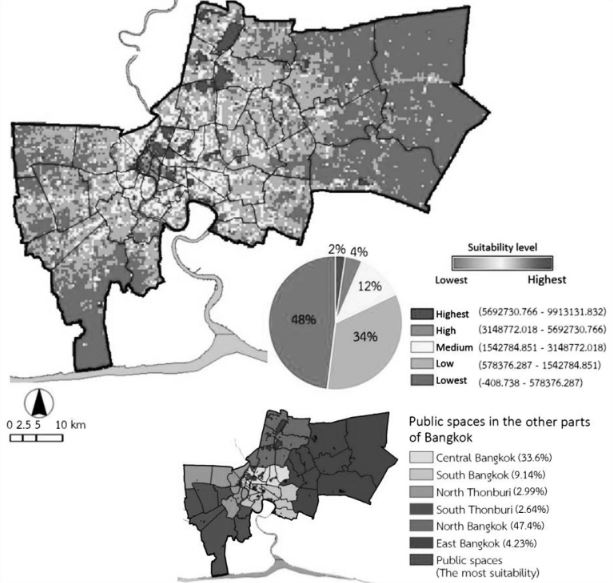The Attitude in Urban Planning of Thai Urban Public Space: A Case Study of Bangkok Metropolitan Area, Thailand
Keywords:
Urban public spaces, Ranking method, Urban development, Creative, Identity, SustainableAbstract
Public space represents the concerning of social, economic and environmental of the country where should lead to sustain the urban development. An objective of this article is to identify zoning of public spaces by using the decision of 80 experts whose working experiences involved in urban planning disciplines. The methodology of the study was designed to incorporate, urban, creative, identity and sustainable issues which are four major criteria for signifying the public spaces in Thai context. The weighted score demonstrated importance of different key urban development policy were ranked by the experts, and integrated with geospatial analysis on Geographic Information System (GIS). Bangkok, the capital of Thailand was selected for the study area. The analyzed zoning by the expert decisions revealed that the most suitability level of area scatters all over Bangkok, covering 4.635 square kilometer or 0.3 percent of Bangkok area. Three groups identifying by locations of public spaces were clustered and their locations concentrates at the inner of Bangkok or city center, the upper part of Bangkok, and scatters sparse outside of the city center, respectively. The results of this study could help for identifying the appropriate zone of public space in Bangkok and its vicinities.
Downloads
References
Asian Development Bank. (2001).Urban indicators for managing cities. Retrieved from https://www.adb.org/sites/default/files/publication/30020/urban-indicators-managing-cities.pdf.
Baker, C. J., & Phongpaichit, P. (2014). Prawattisat Thai Chabub Sungkeb: A history of Thailand (In Thai) [Brief History of Thailand]. Bangkok: Matichon Press.
Ben, S. I., & Gaus, G. F. (1983). Public and private in social life. London: Croom Helm.
Blackmar, E. (2006). Appropriating the commons: The tragedy of property rights discourse. New York: Taylor & Francis.
Carmona, M., Tiesdell, S., Heath, T., & Oc, T. (2010). Public place urban space. Oxford: Architectural Press.
Gehl, J. (2001). Life between buildings, Using public spaces (4th Ed.). Copenhagen: The Danish Architectural Press.
Habermas, J. (1989). The structural transformation of the public sphere. Retrieved from https://suegreenwood.wordpress.com/2013/08/02/habermas-j-structural-transformation-of-the-public-sphere/.
Health Effects Institute. (2018). State of global air 2018 (Special Report). Boston: MA: Health Effects Institute. Retrieved from https://www.stateofglobalair.org/sites/default/files/soga-2018-report.pdf.
Huge, B., Marcus, G., & Richard, G. (2010). Shaping neighbourhoods: For local health and global sustainability (2nd Ed.). New York: Routledge.
Iamtrakul, P., Srivanit, M., & Klaylee, J. (2017). Resilience in urban transport towards hybrid canal-rail connectivity linking Bangkok’ s canal networks to mass rapid transit lines. International Journal of Building, Urban, Interior and Landscape Technology,10, 27-41.
Institute of Academic Development (IAD.). (2015). Lem 1 Prawattisat Thai: Vela lea yuksamai tang prawattisat. (In Thai) [Historical period of Thailand]. Bangkok: Institute of Academic Development [IAD] Press.
Jacobs, J. (1961). The death and life of great American cities. New York: Vintage books.
Kaplan, S., & Kaplan, R. (1982). Cognition and environment: Functioning in an uncertain world (6th Ed.) New York: Preager.
Legatum Institute. (2018). The legatum prosperity index™ 2018 (12th Ed.). Retrieved from https://prosperitysite.s3-accelerate.amazonawscom/2515/4321/8072/2018_Prosperity_Index.pdf.
Lewicka, M. (2008). Place attachment, place identity, and place memory: Restoring the forgotten city past. Retrieved from http://psych.uw.edu.pl/zalacznik/ml/publikacje/Lewicka_JEP_2008.pdf.
Madanipour, A. (2010). Whose public space?. New York: Routledge.
Malczewski, J. (1999). GIS and multi-criteria decision analysis. Ontario, Canada: University of Western Ontario Press.
McGee, G. T. (1967). The southeast asian city: A social geography of the primate cities of southeast Asia. New York: Frederick A. Praeger.
Myerson, D. L. (2006). Parks, people, and places: Making parks accessible to the community. Retrieved from http://uli.org/wpcontent/uploads/2012/07/Report-4-Parks-People-and-Places.ashx_.pdf.
Office of Knowledge Management and Development. (2015). Now urbanized: Lifestyle, city and opportunity. Retrieved from http://www.okmd.or.th/upload/pdf/2560/the%20opportunity%20by%20okmd/Booklet_now-urbanized.pdf.
Paksookcharown, K. (2008). Soi Lat Prayad Palang NGan: Pauen Tee Wang Satharana Khanad Lek - Pauen Tee Tang Sangkhom Khong Chumchon Thai (In Thai) [Energy saving shortcuts: Small public space-small social space inThai communities]. Bangkok: Chulalongkorn University.
Rose, B. (1995). Place and identity: A sense of place. Retrieved from http://project2225.wikispaces.com/file/view/Place+and+identity+-+a+sense+of+place.PDF
Roszkowska, E. (2013). Rank ordering criteria weighting methods-a comparative overview: optimum. Studia Ekonomiczne NR, 5(56), 14-33.
Sittipan, P. (1984). Prawattisat maha anachak Thai (In Thai) [Thai History]. Samut Prakarn: Keawnannakij Press.
Srivanit, M., & Selanon, P. (2017). GIS-based land suitability analysis to support Transit-Oriented Development (TOD) master plan: A case study of the campus station of Thammasat University and its surrounding communities. International Journal of Building, Urban, Interior and Landscape Technology, 9, 49-60.
Stearns, P. N. (2000). The encyclopedia of world history. (6th Ed.). Retrieved from http://shora.tabriz.ir/Uploads/83/cms/user/File/657/E_Book/History/The%20Encyclopedia%20of%20World%20History.pdf.
Stillwell, W. G., Seaver, D. A., & Edwards, W. (1981). A comparison of weight approximation techniques in multiattribute utility decision making. Organizational Behavior and Human Performance, 28(1), 62-77.
Toffler, A. (2012). Knowledge, technology and change in future society. International Journal of Islamic Thought, 1, 54-61.
Tonnelat, S. (2010). The sociology of urban public spaces. Retrieved from https://www.academia.edu/313641/The_Sociology_of_Urban_Public_Spaces.
UNDP. (2015). Sustainable development goals. Retrieved from http://www.undp.org/content/dam/undp/library/corporate/brochure/SDGs_Booklet_Web_En.pdf.
United Nations. (2014). World urbanization prospects: 2014 revision highlights. Retrieved from https://esa.un.org/unpd/wup/publications/files/wup2014-highlights.pdf.
UN-Habitat. (2015). Transforming our world: The 2030 agenda for sustainable development. Retrieved from http://www.un.org/ga/search/view_doc.asp?symbol=A/RES/70/1&Lang=E.
UN-Habitat. (2017). 2018 Revision of world urbanization prospects. Retrieved from https://www.un.org/development/desa/en/news/population/2018-revision-of-world-urbanization-prospects.html.
Wyatt, D. K. (2013). Prawattisat Thai Ruam Samai (In Thai) [Contemporary Thai History]. Bangkok: The foundation for the Promotion of Social Sciences and Humanities Textbooks Project.

Downloads
Published
How to Cite
Issue
Section
License

This work is licensed under a Creative Commons Attribution-NonCommercial-NoDerivatives 4.0 International License.











